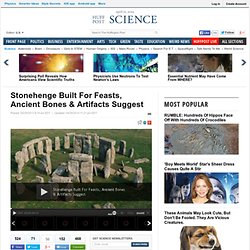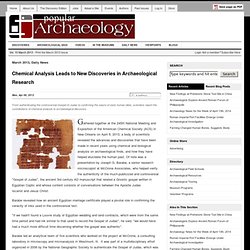

Child murdered in Roman Britain 1,800 years ago came from the Mediterranean. Isotope analysis of the tooth enamel of a child whose remains were discovered in a shallow grave near Hadrian’s Wall has shown that he or she was around 10 years old when murdered, but had lived in the Mediterranean region until the age of 7 or 8.

Discovery of 10,000 artefacts brings Roman London to life – pictures of the top 20 finds. A dig in the heart of London, just yards from the River Thames, has yielded 10,000 finds from across the first 4 centuries of the city’s existence, which experts say “will transform our understanding” of Roman London.

Museum of London archaeologists (MOLA) say the artefacts, which date from the 40s AD to the early 5th century, comprise the largest collection of small finds ever recovered on a single site in London. The 3 acre site on Queen Victoria Street, which is being developed to become media corporation Bloomberg’s European headquarters, contains the bed of the River Walbrook, one of London’s ‘lost’ rivers. The waterlogged river bed provided an anaerobic environment which has perfectly preserved organic materials such as leather and wood. Stonehenge Built For Feasts, Ancient Bones & Artifacts Suggest. By: Tia Ghose, LiveScience Staff Writer Published: 04/24/2013 01:50 PM EDT on LiveScience A site near Stonehenge has revealed archaeological evidence that hunters lived just a mile from Stonehenge roughly 5,000 years prior to the construction of the first stones, new research suggests.

What's more, the site, which was occupied continuously for 3,000 years, had evidence of burning, thousands of flint tool fragments and bones of wild aurochs, a type of extinct giant cow. Popular Archaeology. From authenticating the controversial Gospel of Judas to confirming the nature of early human diets, scientists report the contributions of chemical analysis to archaeological discovery.

Gathered together at the 245th National Meeting and Exposition of the American Chemical Society (ACS) in New Orleans on April 8, 2013, a body of scientists revealed the advances and discoveries that have been made in recent years using chemical and biological analysis on archaeological finds, and how they have helped elucidate the human past. Of note was a presentation by Joseph G. Barabe, a senior research microscopist at McCrone Associates, who helped verify the authenticity of the much-publicized and controversial "Gospel of Judas", the ancient 3rd century AD manuscript that related a Gnostic gospel written in Egyptian Coptic and whose content consists of conversations between the Apostle Judas Iscariot and Jesus Christ.
"We didn't understand it. Other presentations included:
Mayan Blue Pigment Recipe Revealed In New Chemical Analysis Of Ancient Paint. Donkey, Sacrificed In Bronze-Age Ritual, Was Buried With Status Symbol. Bronze-Age Donkey Sacrifice Found in Israel. Archaeologists in southern Israel say they've uncovered a young donkey that was carefully laid to rest on its side more than 3,500 years ago, complete with a copper bridle bit in its mouth and saddle bags on its back.

Its accessories — and the lack of butchery marks on its bones — lead researchers to believe the venerated pack animal was sacrificed and buried as part of a Bronze Age ritual. Donkeys were valuable beasts of burden in the ancient Near East. Donkey caravans helped open up vast trade networks across the Levant and Anatolia in the 18th and 17th centuries B.C., according to archives from Amorite settlements like Mari in modern-day Syria. Ancient Egyptian inscriptions from around the same time show that hundreds of pack donkeys were used in large-scale expeditions to mining sites in the eastern desert and southern Sinai, researchers say.
The animals have even been associated with royalty. Most comprehensive tree of life shows placental mammal diversity exploded after age of dinosaurs. An international team of scientists including University of Florida researchers has generated the most comprehensive tree of life to date on placental mammals, which are those bearing live young, including bats, rodents, whales and humans.

Appearing February 7 in the journal Science, the study details how researchers used both genetic and physical traits to reconstruct the common ancestor of placental mammals, the creature that gave rise to many mammals alive today. The data show that contrary to a commonly held theory, the group diversified after the extinction of dinosaurs 65 million years ago. The research may help scientists better understand how mammals survived past climate change and how they may be impacted by future environmental conditions. UF researchers led the team that analyzed the anatomy of living and fossil primates, including lemurs, monkeys and humans, as well as their closest living relatives, flying lemurs and tree shrews. Tumor In 1,600-Year-Old Roman Corpse Found To Contain Teeth, Bone.
By: Owen Jarus, LiveScience Contributor Published: 01/22/2013 07:00 AM EST on LiveScience In a necropolis in Spain, archaeologists have found the remains of a Roman woman who died in her 30s with a calcified tumor in her pelvis, a bone and four deformed teeth embedded within it.
